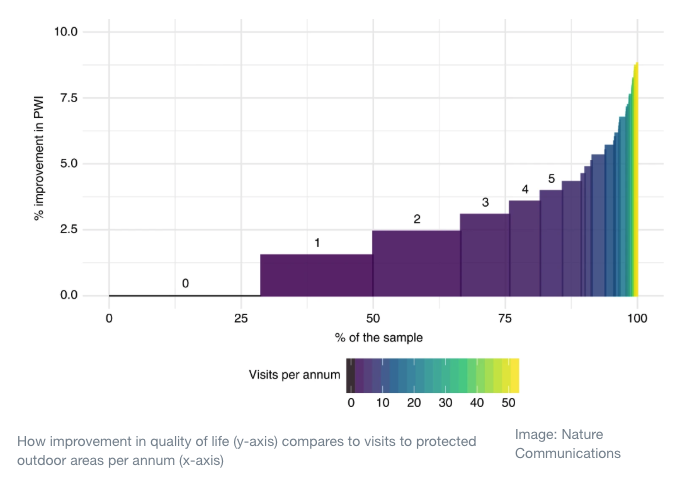|
There's a strong link between spending time outdoors, improved mental health, and quality of life.
22 Nov 2019
Researchers from Griffith University in Queensland, Australia, have put a value on it. By looking at how much people are likely to spend on their healthcare combined with statistics on national park visits, they were able to calculate a dollar value for a quality-adjusted life year, or QALY. One QALY equates to one year in good health. The researchers concluded the economic impact of protected areas, like national parks, on people’s mental health is $6 trillion per year worldwide. How improvement in quality of life (y-axis) compares to visits to protected outdoor areas per annum (x-axis). See chart below. Their report is based on simple logic: "Nature exposure improves human mental health and well-being. Poor mental health imposes major costs on human economies. Therefore, parks have an additional economic value through the mental health of visitors." Professor Ralf Buckley, International Chair in Ecotourism Research at Griffith University, explained. "Everyone spends money on their health, from Band-Aids to weeks in the hospital. Depending on the country, that money might be paid by the individual, a health insurer, or the government. But those costs still exist whether we pay them in cash, via health insurance premiums, or via taxes, and we can track the costs quite precisely." Governments and health insurers use the $/QALY calculation all the time, according to Buckley. It’s a standard way to make decisions around healthcare spending priorities. "Costs are easy to compare," he said. "But what about benefits? They need to know the value per person of the expected improvement in quality of life, multiplied by the number of people affected." DO YOU COME HERE OFTEN? The research team quizzed visitors to two Australian subtropical national parks, using the personal well-being index (PWI), which looks at seven criteria: standard of living, health, achieving in life, relationships, safety, community connectedness, and future security. They compared visitors’ PWI scores with data on the general Australian population and estimates of how many people visit national parks each year. From this, they determined that visiting a national park lifted people’s PWI by 2.2% on average. The conclusion is that there is a link between visits to areas such as national parks and improved mental health and well-being. When transposed onto the $/QALY sum, that translates to a "substantial but previously unrecognized economic value". Just like healthcare costs, the value placed on a QALY varies from one country to another. But according to Buckley, it averages between $200,000 and $250,000. "That might sound a lot," he says. "But imagine you were given a choice between dying right now or living another year in perfect health. How much would you pay? Looked at that way, it doesn’t seem such a big number at all." There are, of course, limits to the amount of wealth and capital people have at their disposal, so the value of a QALY cannot rise non-stop; it's grounded in what people are actually able to pay for the healthcare services they need to improve their lives, rather than a notional value of what their time might be worth to them. Efforts to put a monetary value on health and happiness are always likely to be challenging, due to the very personal nature of what makes any given individual feel rewarded, content and at their best. Research from the University of Oxford’s Saïd Business School recently highlighted a link between happy workers and higher productivity. A 13% increase in sales among BT staff was found to coincide with workers feeling happier, which may further demonstrate the economic impact of looking after employees’ well-being. Comments are closed.
|
Contact UsFollow us on Facebook and YouTube
|





